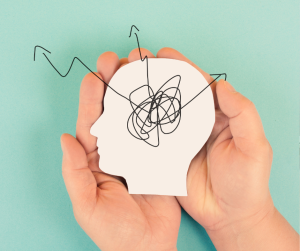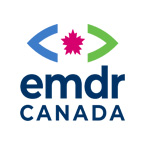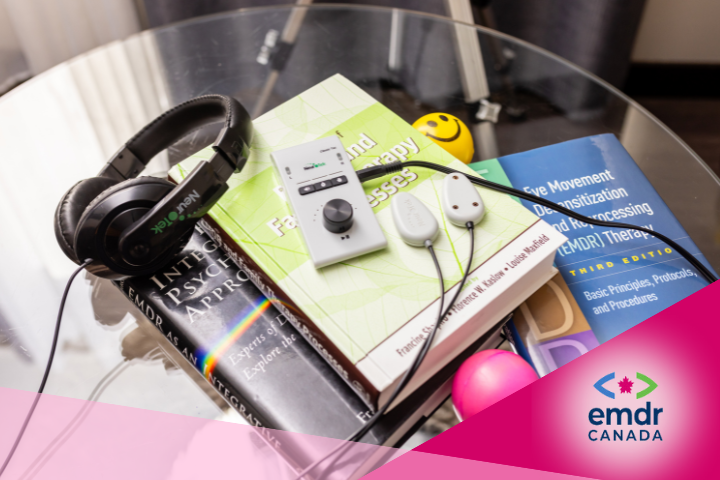Despite the name “Eye Movement Desensitization and Reprocessing” therapy, eye movement is not a necessary part of EMDR. Tactile and auditory stimulation are also well-researched and proven options, making EMDR therapy more accessible to people with varying needs, abilities, and preferences. Individuals considering EMDR in Canada may find it helpful to know about these different modalities as they decide on the best treatment option(s) for them.
What is the purpose of eye movement in traditional EMDR?
The underlying purpose of the eye movement in EMDR is bilateral stimulation. Bilateral stimulation is a therapeutic technique that involves stimulating both sides of the body or brain in a rhythmic and repetitive manner. During bilateral stimulation, the therapist guides the client to focus on specific stimuli that alternate between the left and right sides. The back-and-forth movement or stimulation is thought to mimic the natural processing that occurs during REM (rapid eye movement) sleep, facilitating the reprocessing of traumatic memories.
In the most common form of bilateral stimulation, EMDR clients will follow a moving object or a light with their eyes. However, there are other modalities that can be just as effective, such as gentle tapping on different sides of the body (tactile), or listening to alternating sounds through headphones (auditory).
What other types of bilateral stimulation are used for EMDR in Canada?
Therapists in Canada may use one or more of the following techniques, depending on their preferences and the needs of their client(s).
Using Touch (Tactile Bilateral Stimulation).
This can be done through:
- Manual self-tapping: The client can use a “butterfly hug” to tap on either side of their body, or tap either leg as instructed by the therapist.
- Tappers or buzzers: These instruments are typically placed on or held by the client and deliver a very soft, gentle tactile bilateral stimulation.
- Wearable buzzers: These often attach to the client’s wrist or other body part, delivering bilateral vibrations electronically.
Using Sound (Auditory Bilateral Stimulation)
This can be done through:
- Bilateral music: Using headphones, the client listens to musical tones that rotate between ears.
- Beeper/tones: Again, using headphones, the therapist delivers beeping noises that rotate between ears.
- Snapping fingers: The therapist uses their hands to make noises on either side of the patient.
Are other forms of bilateral stimulation effective?
While most EMDR research involves eye movement, emerging evidence on alternative modalities is very promising. One of the benefits of EMDR is that it is highly adaptable, and some clients may actually find these alternatives to be a better fit than bilateral stimulation involving the eyes. This is especially true for individuals who have the following conditions:
- Seizure disorders, Traumatic Brain Injuries (TBI), and/or Functional neurological disorder, which may be triggered by rapid eye movements
- Certain visual impairments
- Challenges with focus (for example, due to ADHD)
- Dry eyes (for example, due to Sjögren’s syndrome)
 Individual preference is also a factor. Some clients may feel more at ease with a certain modality, depending on their history, background, sensory sensitivities, and beyond. For example, children often prefer tappers because of the buzz sensation, which can feel nice on the skin, or because of the light that often accompanies the tactile feeling. It is a good idea for therapists and clients to discuss options and preferences prior to beginning treatment and pick a modality that both are comfortable using.
Individual preference is also a factor. Some clients may feel more at ease with a certain modality, depending on their history, background, sensory sensitivities, and beyond. For example, children often prefer tappers because of the buzz sensation, which can feel nice on the skin, or because of the light that often accompanies the tactile feeling. It is a good idea for therapists and clients to discuss options and preferences prior to beginning treatment and pick a modality that both are comfortable using.
Different modalities can help more people in Canada access EMDR
Non-eye movement EMDR can help make this therapy accessible to people who may struggle with the eye movement option, for both medical and preference-related reasons. Offering alternatives like these can also help clients feel like they have more control over the process, making it a more collaborative and strengths-based treatment.
EMDR Canada proudly advocates for increased access to EMDR across the country. There are so many people struggling with mental health across the country, and we are working together to help make the gold standard therapy for PTSD be as widely accessible as possible.
If you are considering EMDR, we hope this detailed information about options helps you make informed decisions about your health and treatment. We welcome you to learn more about how EMDR works here, or use our directory to find a therapist that can help you.



